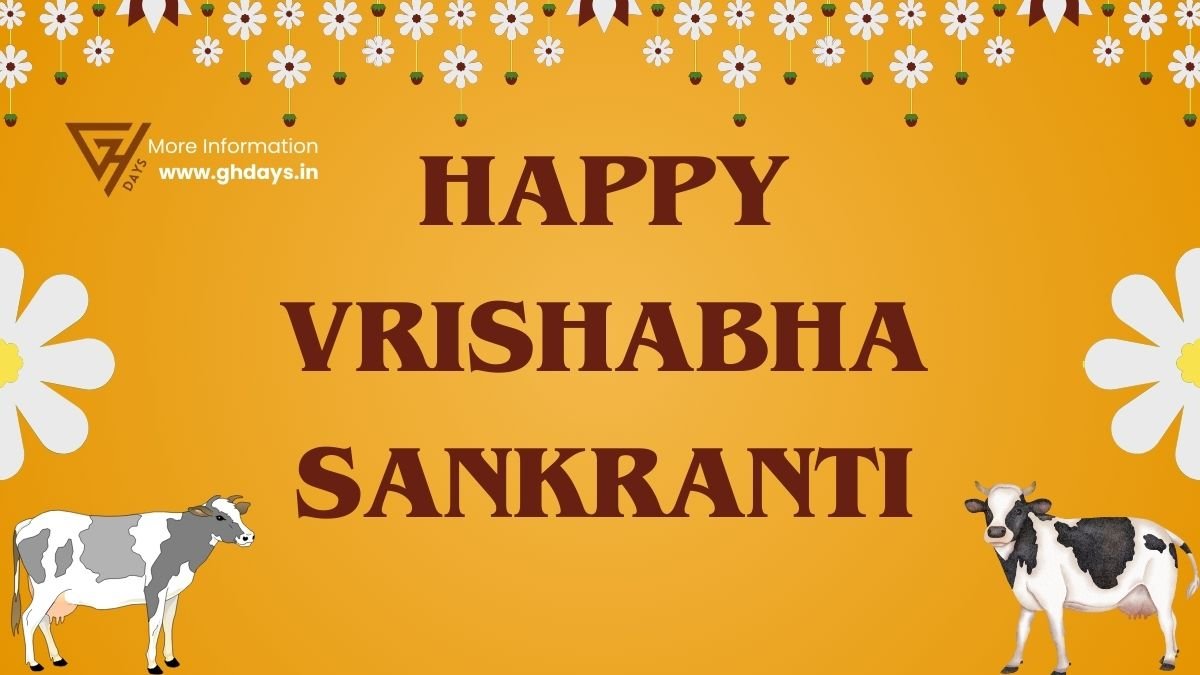Vrishabha Sankranti Date 2025: Meaning, Importance, and Puja Timings – GHdays.in
In the Hindu Solar Calendar, Vrishabha Sankranti symbolizes a significant shift as the Sun moves from Mesha rashi to Vrishabha rashi, marking the transition from Aries to Taurus Zodiac sign. Celebrated during the month of ‘Vaishakh’ in various regional calendars such as Marathi, Kannada, Gujarati, and Telugu, and in the North Indian calendar during the Hindu month of ‘Jyeshta’, Vrishabha Sankranti is known as Vrushabha Sankraman in the Southern states of India.
This festival heralds the beginning of the Vrishabha season and is a momentous occasion in the solar calendar. It also signals the commencement of Vaigasi Masam in Tamil calendar, ‘Edavam masam’ in Malayalam calendar, and ‘Jyeshto mash’ in the Bengali calendar. In Orissa, this day is celebrated as ‘Brusha Sankranti’.
The term ‘vrushabha’ in Sanskrit translates to ‘a bull’, associated with Lord Shiva’s carrier, Nandi, in Hindu mythology. The connection between the bull and religious symbolism holds great importance for devotees, making Vrishabha Sankranti a spiritually significant event. On this auspicious day, people offer prayers to Lord Vishnu seeking blessings for a joyful and prosperous life, as well as liberation from the cycle of rebirth to attain salvation.
Vrishabha Sankranti Date 2025: May 14, Wednesday
Table of Contents
Vrishabha Sankranti Date and Puja Timings 2025
On the auspicious occasion of Vrishabha Sankranti falling on Wednesday, May 14, 2025, the celestial energies align to bring forth moments of great significance. The Punya Kaal Muhurta for Vrishabha Sankranti spans from 12:35 to 19:06, offering a window of 6 hours and 31 minutes for engaging in virtuous and meritorious activities. Within this time frame, the Maha Punya Kala from 16:55 to 19:06 holds heightened spiritual potential lasting for 2 hours and 10 minutes. As the clock strikes 12:21 AM on May 15, 2025, the Vrishabha Sankranti Moment marks a transition into a new phase, symbolizing renewal and positive energy influx.
| Vrishabha Sankranti Date 2023 | Monday, 15th of May |
| Vrishabha Sankranti Date 2024 | Tuesday, 14th of May |
| Vrishabha Sankranti Date 2025 | Thursday, 15th of May |
| Vrishabha Sankranti Date 2026 | Friday, 15th of May |
| Vrishabha Sankranti Date 2027 | Saturday, 15th of May |
| Vrishabha Sankranti Date 2028 | Sunday, 14th of May |
Significance of Vrishabha Sankranti
Vrishabha Sankranti is considered an auspicious day in Hindu mythology, as it marks the beginning of the solar month of Vrishabha (Taurus). This event is also celebrated as a harvest festival in various parts of India, where people offer prayers and thanks to Lord Vishnu for a bountiful yield. The significance of this day lies in its representation of growth, abundance and prosperity
It is believed that taking a dip in sacred water bodies on this day can cleanse one’s sins and bring spiritual enlightenment. In addition, many temples organize special rituals and feasts to commemorate this important occasion. People also exchange traditional sweets such as kheer or puran poli with friends and family as a symbol of love and unity.
The celebration continues well into the evening, with folk dances, music performances, and firecracker displays adding to the festive atmosphere. Many cities also hold processions featuring decorated statues or idols of Lord Vishnu riding his vehicle – the bull Nandi – accompanied by devotees singing hymns in praise of the deity. This community gathering promotes social harmony among different cultural groups within society. The next morning after Vrishabha Sankranti festivities end sees farmers eager to get back to their land for cultivating new crops during this favorable season.
As observed across centuries by Hindus all over India, Vrishabha Sankranti signifies new beginnings – whether in agriculture or personal life –and stresses on living harmoniously with nature while maintaining strong religious beliefs during times both good or bad.
Rituals on Vrishabha Sankranti
Vrishabha Sankranti, a day of great significance for Hindu followers, is marked by the practice of Daan, considered highly auspicious. The act of ‘Godan’, which involves gifting a sacred cow to a revered Brahmin, holds particular importance when carried out on this auspicious occasion.
In addition to these rituals, some devotees choose to observe a fast on Vrishabha Sankranti, known as ‘Vrishabha Sankranti vrat’. Rising before dawn, they partake in a purifying bath and proceed to worship ‘Rishabharudar’, an epithet of Lord Shiva. A special offering, consisting of payasham and rice, known as ‘Bhog’, is prepared and presented to the deity. This Bhog is then shared and enjoyed with family members. Those engaging in the Vrishabha Sankranti vrat traditionally opt to sleep on the ground throughout the night.
On this auspicious day, devotees also make pilgrimages to temples dedicated to Lord Vishnu, seeking divine guidance to help them distinguish between right and wrong. The revered Jagannath Temple in Puri makes special arrangements for this occasion.
A common practice among followers on Vrishabha Sankranti is the Sankramana Snan, a sacred bathing ritual undertaken at Hindu pilgrimage sites. Through this act, devotees pay homage to the Sun God and honor their ancestors. Additionally, many choose to perform Pitra Tarpan, a ritual offering aimed at granting peace to departed family members.
